Questions with Answers, Solution | Measurements | Chapter 2 | 8th Maths - Exercise 2.2 (Perimeter and Area of Combined shapes) | 8th Maths : Chapter 2 : Measurements
Chapter: 8th Maths : Chapter 2 : Measurements
Exercise 2.2 (Perimeter and Area of Combined shapes)
Exercise 2.2
1. Find the perimeter and area of the
figures given below. (π = 22/7)

Solution:
(i)
Length of the arc of the semicircle = (1/2) × 2πr units
= (22/7) × (7/2) m = 11 m
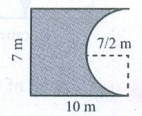
∴ Perimeter = Sum of all lengths of sides that form the closed
boundary
P = 11 +10 + 7 + 10 m
Perimeter = 38 m
Area = Area of the rectangle − Area of semicircle
= (l × b) – (1/2) πr2 sq. units
= (10 × 7) – (1/2) × (22/7)
× (7/2) × (7/2)
= 70 – [(11 × 7) / (2 × 2)] = [280 – 77] / 4 = 203/4
= 50.75 m2 (approx)
Area of the figure = 50.75 m2 approx.
(ii) Perimeter = sum of outside lengths
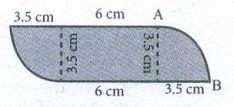
Length of the arc of quadrant circle = (1/4) × 2πr units
= (1/2) × (22/7) × 3.5 cm
= 11 × 0.5 cm = 5.5 cm
∴ Length of arc of 2
sectors = 2 × 5.5 cm
= 11 cm
∴ Perimeter P = 11+ 6 + 3.5 + 6 + 3.5 cm
P = 30 cm
Area = Area of 2 quadrant circle + Area of a rectangle.
= 2 × (1/4)πr2 + lb sq. units
= (1/2 × 22/7 × 3.5 × 3.5) + (6 × 3.5) cm2
= (11 × 3.5 × 0.5) + 21 cm2
= (19.25 + 21) cm2 = 40.25 cm2
Area = 40.25 cm2 approx
2. Find the area of the shaded part in
the following figures. ( π = 3.14
)

Solution:
(i)
Area of the shaded part = Area of 4 quadrant circles of radius 10/2
cm
= 4 × 1/4 × πr2 = 3.14 × 10/2 × 10/2 cm2
= 314 / 4 cm2 =
78.5 cm2
Area of the shaded part = 78.5 cm2
Area of the unshaded part = Area of the square − Area of shaded
part
= a2 – 78.5 cm2 = (10 × 10) − 78.5
cm2
= 100 − 78.5 cm2 = 21.5 cm2
Area of the unshaded part = 21.5 cm2 (approximately)
(ii)
Area of the shaded part = Area of semicircle − Area of the
triangle
= ( 1/2 πr2) – (1/2 bh) cm2

= (½) × 3.14 × 7 × 7 – (½) × 14 × 7 cm2
= [ 153.86 / 2 ] – 49 cm2 = 76.93 – 49 cm2
= 27.93 cm2
∴ Area of the shaded part
= 27.93 cm2 (approximately)
3. Find the area of the combined figure
given which is got by the joining of two parallelograms.
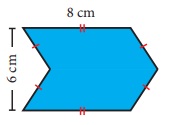
Solution:
Area of the figure = Area of 2 parallelograms with base 8 cm and
height 3 cm
= 2 × (bh) sq. units
= 2 × 8 × 3 cm2 = 48 cm2
∴ Area of the given figure
= 48 cm2
4. Find the area of the combined figure
given, formed by joining a semicircle of diameter 6 cm with a triangle of base 6 cm
and height 9 cm. ( π = 3.14 )

Solution:
Area of the figure = Area of the semicircle of radius 3 cm + 2
(Area of triangle with b = 9 cm and h = 3 cm)
= ( (1/2) πr2 ) + (2 × [ 1/2 bh ] ) sq.
units

= 1/2 × 3.14 × 3 × 3 + (2 × 1/2 × 9 × 3) cm2
= [28.26 / 2] + 27 cm2 = 14.13 + 27 cm2 =
41.13 cm2
∴ Area of the figure = 41.13 cm2 (approximately)
5. The door mat which is hexagonal in
shape has the following measures as given in the figure. Find its area.
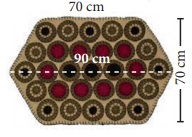
Solution:
Area of the doormat = Area of 2 trapezium
Height of the trapezium h = 70/2 cm; a = 90 cm; b
= 70 cm
∴ Area of the trapezium = 1/2 [ h (a + b) ] sq.
units
Area of the doormat = 2 ×
(1/2) × 35 (90 + 70 ) cm2
= 35 × 160 cm2 = 5600 cm2
∴ Area of the door mat = 5600 cm2
6. A rocket drawing has the measures
as given in the figure. Find its area

Solution:
Area = Area of a rectangle + Area of a triangle + Area of a
trapezium
For rectangle length l = 120 − 20 − 20 cm = 80 cm
Breadth b = 30 cm
For the triangle base = 30 cm
Height = 20 cm
For the trapezium height h = 20 cm
Parallel sided a = 50 cm
b = 30 cm
∴ Area of the figure = (l × b) + (1/2 × base × height)
+ 1/2 × h × (a + b) sq. units

= (80 × 30) + (1/2 × 30 × 20) + 1/2 × 20 × (50 + 30) cm2
= 2400 + 300 + 800 cm2 = 3500 cm2
Area of the figure = 3500 cm2
7. Find the area of the irregular polygon
shaped fields given below.
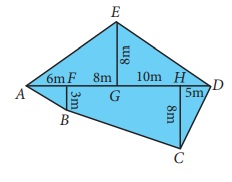
Solution:
Area of the field = Area of trapezium FBCH + Area of ΔDHC + Area
of ΔEGD + Area of ΔEGA + Area of ΔBFA

Area of the triangle = 1/2 bh sq. units
Area of the trapezium = 1/2 × h × (a + b) sq. units
Area of the trapezium FBCH = 1/2 × (10 + 8) × (8 + 3) m2
= 9 × 11 = 99 m2 …(1)
Area of the ΔDHC = 1/2 × 8 × 5 m2 = 20 m2 ...(2)
Area of ΔEGD = 1/2 × 8 × 15 m2 = 60 m2 ...(3)
Area of ΔEGA = 1/2 × 8 × (8 + 6) m2 = 4 × 14 m2
= 56 m2 ...(4)
Area of ΔBFA = 1/2 × 3 × 6 m2 = 9 m2 ...(4)
∴ Area of the field = 99 + 20 + 60 + 56 + 9 m2
= 244 m2
Area of the field = 244 m2
Answer:
Exercise
2.2
1. 38 m, 50.75 m2 (approximately) (ii) 30 cm,40.25 cm2 (approximately)
2 (i) 21.5 cm2 (approximately) (ii) 27.93 cm2
(approximately)
3. 48 cm2
4. 41.13 cm2 (approximately)
5. 5600 cm2
6. 3500 cm2
7. 244 m2
Related Topics